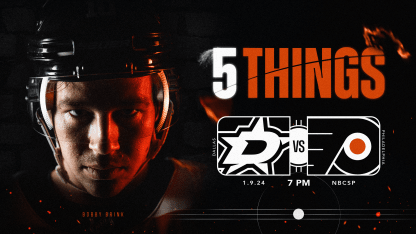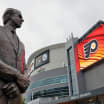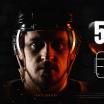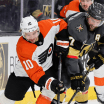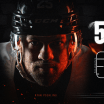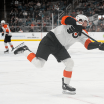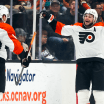On Ed Snider Legacy Night at Wells Fargo Center, John Tortorella's Philadelphia Flyers (17-19-5) are home to take on Pete DeBoer's Dallas Stars (25-13-1) on Thursday evening. Game time is 7:00 p.m. EST,
The game will be televised on NBCSP. The radio broadcast is on 97.5 The Fanatic with an online simulcast on Flyers Radio 24/7.
Thursday's game is the first of two meetings this season between Philly and Dallas. The clubs will rematch at American Airlines Center on March 22.
For the Flyers, Tuesday's game marks the start of the statistical second half of the 2024-25 season. The Flyers are coming off a disappointing home-and-home set against the Toronto Maple Leafs that saw Philly play a pair of strong all-around games but come away with 3-2 overtime (road) and 3-2 regulation (home) losses despite outplaying a very tough opponent for long stretches.
Through 41 games, Travis Konecny leads the club with 20 goals, 25 assists and 45 points. Fellow 4 Nations Face-Off selection Travis Sanheim paces the Philadelphia defense corps with 21 points (six goals, 15 assists).
On the Dallas side, veteran center Matt Duchene tops the club with 16 goals, 22 assists and 38 points. Meanwhile, without much leaguewide fanfare, 23-year-old defenseman Thomas Harley is having an excellent season including 21 points (six goals, 15 assists) and a team-best traditional +19.
Here are five things to watch in Thursday's tilt.
1. Maintain the recent process
The Flyers' record since the leaguewide holiday break (2-3-1) does not reflect how well the team played overall on most of the last six games. Actually, the Flyers' least impressive performance was one of their two wins: a 3-1 victory in Anaheim on Dec. 28.
Since that point, the Flyers have played far more good minutes than poor ones. Overall, they've forechecked and defended quite well at 5-on-5, especially in three of the last four games against a series of opponents who are probable Stanley Cup playoff clubs.
So why have the Flyers gone 1-3-1 over the last five games? In a couple of the losses, goaltending lapses on off-angle shots or preventable rebounds left out in the slot proved fatal. Meanwhile, over the last three games, the Flyers have scored a combined six goals despite a healthy volume of scoring chances.
The Stars represent yet another high-caliber opponent during a challenging stretch of the season: a road game in Vegas, the home-and-home set against the Maple Leafs and Thursday's game have come at the Flyers sequentially. The defending Stanley Cup champion Florida Panthers loom on the schedule early next week.
Bottom line: The Flyers must stick with the same process they adhered to in the two games against Toronto: take away the middle of the ice, generate up-ice puck pressure, get tone-setting and/or stabilizing shifts, etc. Beyond that, Philly has to finish their own chances better than they did against the Leafs.
The Stars are a dangerous attacking team when they can generate stretch passes from the likes of Miro Heiskanen (14 assists) and Harley up their talented forward corps. Beware of odd-man rushes in transition.
The Stars also are quite good at generating pass outs from below the goal line. Maintaining strong puck support up-ice and own-zone positional structure is vital for the Flyers to successfully combat the Dallas attack.
2. Rookie watch: Michkov and Stankoven
Dynamic Flyers rookie winger Matvei Michkov and playmaking Stars counterpart Logan Stankoven racked up points at impressive clips early this season. Of late, however, both have found points much harder to come by.
Armed with pre-scouts, opponents have a "book" on how to take away time and space from the two players. It is now up to Michkov and Stankoven to consistently make the necessary adjustments to counteract what opponents are doing against them.
Michkov is still second on the Flyers -- and among NHL rookies -- with 12 goals and 29 points but has just one goal and four assists to show for his last 14 games.
That said, Tuesday's home game against Toronto was a very promising sign for the gifted Russian winger. Michkov was in the thick of a slew of Flyers scoring chances.
On the potential goal-scoring side, Michov generated eight shots on goal including two blistering one-timers and a chance in a scramble near the net where the puck was swept away by veteran Max Pacioretty just before it could cross the goal line.
On the playmaking side, Michkov set up potential Grade A chances for Morgan Frost (first period) and Owen Tippett (with a chance to tie the game late in the third period). Unfortunately, the pass to Frost at the right post didn't connect and a one-timer feed to Tippett at the bottom of the left circle with a half-open net was fired off target.
Michkov isn't known for his defensive play and is still working on going to the right spots consistently when up ice. That said, he had a good game in both areas in Tuesday's game, especially on one backchecking sequence in particular.
In short, while there was no scoresheet payoff for Michkov on Tuesday, he played a whale of a game. He did so despite missing a couple of early third period shifts following a D-zone collision with teammate Scott Laughton. If Michkov can follow up Tuesday's performance with a similar effort against the Stars and upcoming opponents, his next surge of points probably won't be far behind.
In Stankoven's case, points have been sparse since mid-November. Over his last 22 games (dating back to November 26 against the Minnesota Wild), Stankoven has posted just four points (zero goals, four assists) and been moved down in the lineup.
Earlier in the season, Stankoven was playing regularly in the top six at five-on-five with the likes of Roope Hintz and Jason Robertson. He also saw time on the first power play unit. Most recently, he's been on right wing on the third line (with Sam Steel and Mavrik Bourque in Tuesday's comeback 5-4 OT win against the New York Rangers). Stankoven is presently on the second power play unit.
Stankoven has excellent ice vision and puck distribution skills. Now that teams are checking him much more tightly, the diminutive but gifted forward will need to do a better job of protecting the puck from being taken away from him or lanes being jammed up and the pass blocked away.
3. The Cates Line
Over the last six weeks, on nearly a game-in and game-out basis, the Flyers most effective line on both sides of the puck has been the trio with Noah Cates centering Tyson Foerster and Bobby Brink.
Cates and Foerster in particular have been red hot offensively of late. The line collectively has been excellent in "checking forward" (as Tortorella describes puck pressure that gets opponents on their heels). The line has also absorbed the toughest defensive zone minutes and often been tabbed for the first shift of each period.
On Tuesday, frequently matched up against Auston Matthews' line, the Cates line spent more time defending than attacking. Overall, the line still did a good job at containing play to the perimeter ("bend but don't break mode") although it had a rare night where the underlying metrics looked like the line struggled. On that night, other lines -- especially the trio of Michkov, Frost and Laughton -- had more opportunities to attack because the Cates line did the heavy lifting defensively.
Playing against Dallas, the Cates line will likely see shifts head-to-head versus the Hintz and Duchene lines. Ideally, Foerster, Cates and Brink will force those lines to play in their own end zone. That's what Philly's line has been doing so consistently well (and getting points) over the last month. However, if it does work out that the Cates line spends a lot of its energy in a defensive posture, they are also capable of minimizing dangerous scoring chances.
It's exceptionally hard to keep Dallas quiet all game: it's a deep team with a lot of fire power. However, the Flyers managed to do just that in one of last season's two meetings: a dominating 5-1 home win in which the Flyers outshot the Stars by a 43-15 margin.
A strong night from the Cates line would be a good start toward replicating that process one calendar year since the Flyers last played the Stars. It would be exceptionally hard to dominate Thursday's game to nearly the same degree, but it's the same recipe of ingredients. The Cates line has been modeling that process from the entire team of late.
4. Power play: Entries and set ups
Recently, the Flyers long-suffering power play found a mini oasis that saw them generate two power play goals (excluding a would-be goal that was disallowed upon a coach's challenge for an initial offside entry roughly 20 seconds before the goal was scored).
Even on some power plays that did not result in a goal, the Flyers put forth extensive attack zone time and generated multiple scoring chances. Unfortunately, the power play stumbled again overall in the home-and-home against Toronto.
What did the power play do right during the mini-surge that has since gone awry again? Start with the outcome of offensive zone faceoffs, especially the first draw of the advantage. When the Flyers have won the faceoff, they've been able recently to generate crisp puck movement with three or four rapid touches leading to a scoring chance.
When Philly has lost the draw or the puck has otherwise exited the attack zone (cleared by the opposing PK or unable to be held in the offensive zone up high), the Flyers have struggled to reload. Entries and personnel set ups are spotty, retrievals are sparse on dump-in.
If you can't enter the zone cleanly and get set up or retrieve the puck and get set up on a dump-in, the power play will go nowhere in a hurry. Winning the initial draw and moving the puck is Philly's main antidote to the problem. Meanwhile, the regroups and re-entries and retrievals must get better.
Otherwise, evey power play is nearly fully dependent on winning the draw cleanly and getting set up immediately. Hopefully for the Flyers, they win their initial draws. But Plan B has to come together much more cohesively if the draw is not won or a puck hops past the point.
5. Behind Enemy Lines: The Stars' Old Guard
Nowadays when playing against Dallas, much of the focus inevitably starts with containing the aforementioned players. Power forward Robertson -- who has burned the Flyers regularly the last few years -- is especially dangerous. So is Hintz.
Meanwhile, players such as Wyatt Johnston and winger Evgenii Dadonov present opponents with an added layer of challenge to track to track and contain. It isn't just the Hintz line that is hard to play against.
For purposes of this game's edition of 5 Things, however, we will focus on the Stars' longest-tenured veteran: captain Jamie Benn (11 goals, 29 points). Along with the injured Tyler Seguin (hip surgery, out since December 1), the heartbeat of the Stars still beats through Benn.
When Benn is on top of his game -- locked in on the forecheck, attacking near the net, making his presence felt from a physical standpoint, laying his body on the line to suppress opposition shots, rushing in to defend teammates -- the entire club still tends to follow his lead. He may not be an Art Ross Trophy candidate anymore at age 35, but every player in the Dallas locker room draws energy off their longtime captain.

